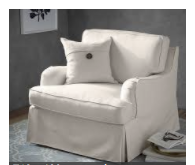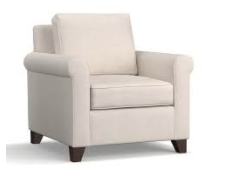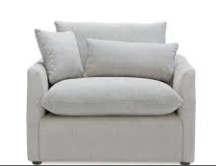Hello, I have begun to model more everyday items as a means to practice. I began modelling this chair but I do not think I have done a very good job. If someone more experienced has some time please check the model (i think I have enabled the download option but I have never posted before and I am not sure here is another link just in case https://drive.google.com/open?id=0B6aAE5GMoQ5RTWExR3lEb01YdjA ) and tell me how my model looks to you. Thanks.
I think you did a terrific job on your chair. Practice make perfect in Blender plus it helps you learn and retain commands and such. You are doing great! The only thing I see is you may want to lower, where the taper out wards begins to the top/back of the armrests. Similar to this type of chair below.

Or, here are a couple more options regarding the usage of different types of back cushions for your chair. Using the body of your chair as a base, add different types of cushions , which will give you at least 3 different chairs. Change the arm rests on your basic chair and you have even more different chairs! 


You probably have already thought of this but going to share it anyway. When I model furniture, I tend to search the Internet for images of what I wish to create (table, chair, sofa, etc.). Often, I will look at online sites selling furniture for reference images. Many sites provide you with images of front, side, and back of the the furniture (depends on what it is), which you can screen capture and download to your computer. You can either view in an image viewer or, load then into Blender for use modeling.
FYI–YouTube has a bunch of video tutorials on modeling furniture that might be of use to you. I typed in their search Blender chair modeling and it gave me lots of results! Don’t be afraid to watch older videos using different versions of Blender. Usually, if there is a difference in features you can figure them out. Mostly, more features are added and/or older features are moved around the menus. If the videos are speed modeled or they speak to fast making it difficult to follow, slow down the speed of the video (is under the icon that looks like a cog). Rewind is our friend 
The great thing about Blender there is usually not a single right way to create something but may different ways of doing so. You just have to decide the way you wish to create!
Thank you @Morgaine_Christensen, I’ll definitely use what you said in my next model. Did you get a chance to look at my actual blend file? And if so what do you think of the topology? This is an issue that I always think I get wrong.
No, sorry I didn’t download the file or look at it. What do you feel is wrong with your topology?
Topology wise, it’s a bit of a mess if I’m honest. On certain areas you have a nice flow of quads, but then they meet an abrupt end when they hit the n-gons. It’s good practice to only model in quads (and in certain cases, tris if it’s unavoidable). Then there’s also a point where you have faces overlapping each other. It’s a small nitpick since it’s hidden away.
An example of the n-gons:
Overlapping faces:
As for topology, Blender Guru did an awesome tutorial recently working on an anvil. It’s not necessarily relevant subject wise, but he did do a fair bit covering topology. So it may or may not be a good reference to you, only if you’re interested.
Anywho, if you can get those ironed out you’ll have a solid model! Keep it up
Thanks for the images, ChilledEagle.
George, as Chilled Eagle pointed out try to avoid n-gons where possible. They can really make a mess of your geometry. If you use caution, you can delete the face of the n-gon, then split the lines around/related to the n-gons to create a quad. Once you have that, you can fill the quad with a face. You may have to move the new face/faces around to smooth out your model.you Watch your loop cuts carefully. Try to keep them equal distance from one another so you have nice even quads, which should assist in avoiding overlap. Where you do have overlap, consider removing one of the edge loops and/or merging vertices.
Most of all keep practicing! The more you practice things will really start to click and then you will say to yourself…duh, now I understand. I know it is usually what happens to me. Another suggestion is, please keep your models even if you think they are terrible. As you gain experience and learn more, go back and look at your older models. Not only is this good to see the knowledge you gain, it will help you to see possible mistakes, which in turn assist you in creating better models. Mistakes are a good learning tool!
I don’t know how far along you are in the course but, I think Micheal’s course is one of the best out there…if not THE best, for learning Blender. Just be patient with yourself, I think you are doing very well.
Thank you @ChilledEagle and @Morgaine_Christensen
That blender guru tutorial will definitely help and I am confident that my next post will have immaculate polygons 
